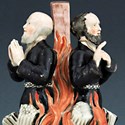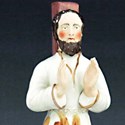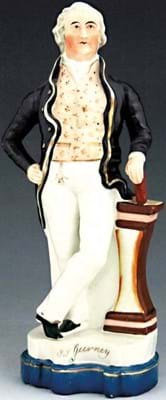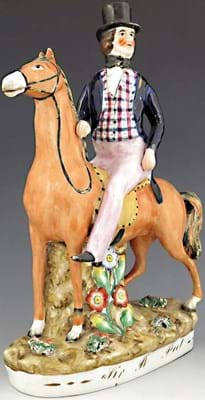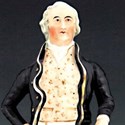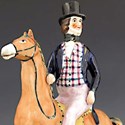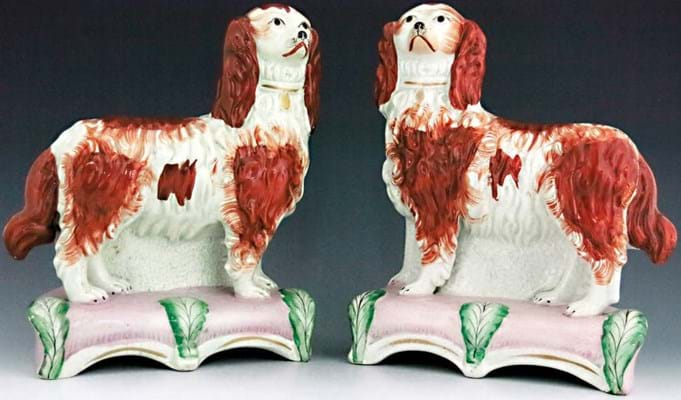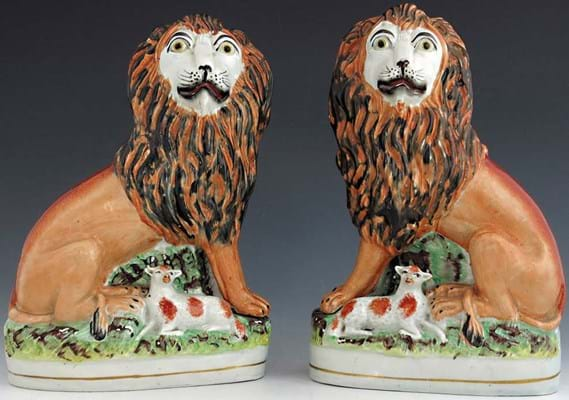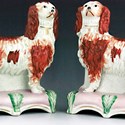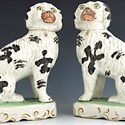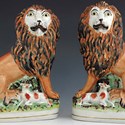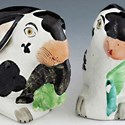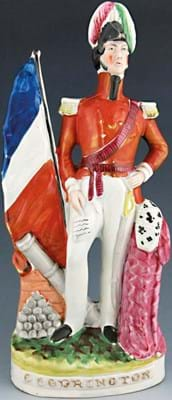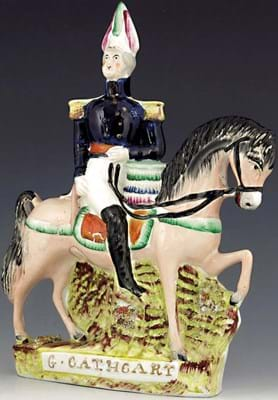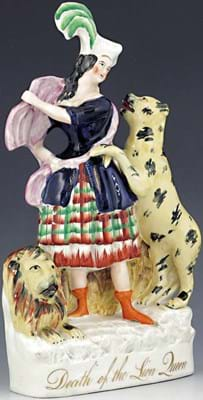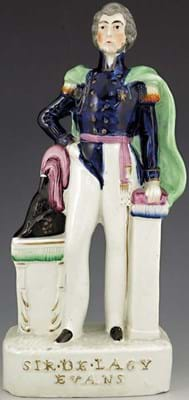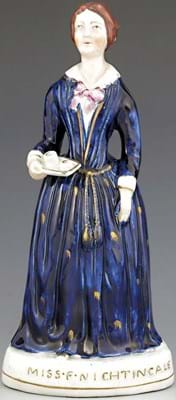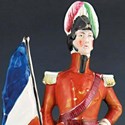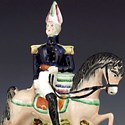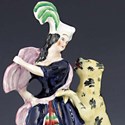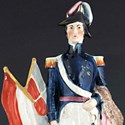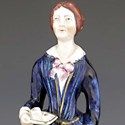As a hotbed of non-conformism and temperance in the 19th century, the Staffordshire potters created an unusually large number of figures celebrating key names in the history of the Protestant religion – from influential Methodist and Baptist preachers and clerics to celebrated theologians.
One particularly rare group of Victorian figures, in the manner of the Burslem potter Thomas Parr, remember some of the Protestant martyrs burnt at the stake during the reign of Mary I.
Two of these were among the best-performing lots of the Harry Ryans (1927-2021) collection of Staffordshire portrait and animal groups offered by Kinghams (23% buyer’s premium) in Moreton-in- Marsh on May 27-28.
They are not for the faint hearted.
Made c.1860, a group of bishops Ridley and Latimer standing back-to-back in a burning pyre carried the title and inscription Be of good comfort, Master Ridley, and play the man: we shall this day light such a candle, by God’s grace, in England, as, I trust, shall never be put out. Similarly, a figure of Archbishop Thomas Cranmer modelled in a gesture of prayer as the flames lick his white robe was inscribed Burned at Oxford, March 21, 1556.
Estimated at £100-150 apiece, they sold on account of their rarity for £2200 each via thesaleroom.com.
The son of a Yorkshire coal miner, Ryans never lost his accent despite living in London for over 60 years. After a brief teaching career, he began trading on Portobello Road, specialising in Victorian-era Staffordshire pottery and paintings on glass, first in Richmond, then in South Kensington.
His personal collection of around 200 Staffordshire ‘flatbacks’ was distinguished by its focus on rarity, detail, condition and some distinct thematic strengths.
Dogs bark back
As a general rule prices for most pairs of Staffordshire dogs, the quintessential Victorian fireside ornament, have dipped markedly in the past generation. Some 25 or 30 years ago they were far more expensive than now.
But there are exceptions. A pair of 8in (20cm) recumbent greyhounds with ‘blackberry’ spots and ‘Disraeli’ curls by ‘the Turquoise factory’ sold for £6400 at W&H Peacock (17.5% buyer’s premium) in Bedford in April – the highest sum paid in the Victorian Staffordshire category for many years.
Ryans owned a similarly desirable pair of greyhounds, depicting the hare coursers Master McGrath, owned by Lord Lurgan, and Pretender, belonging to Mr Punchard. They probably date from c.1871, the year the Irish champion Master McGrath won the Waterloo Cup for the third time, defeating England’s racing pride Pretender. These figures occasionally appear for sale separately but the pair, estimated at £300-500, realised £3800 at Kinghams.
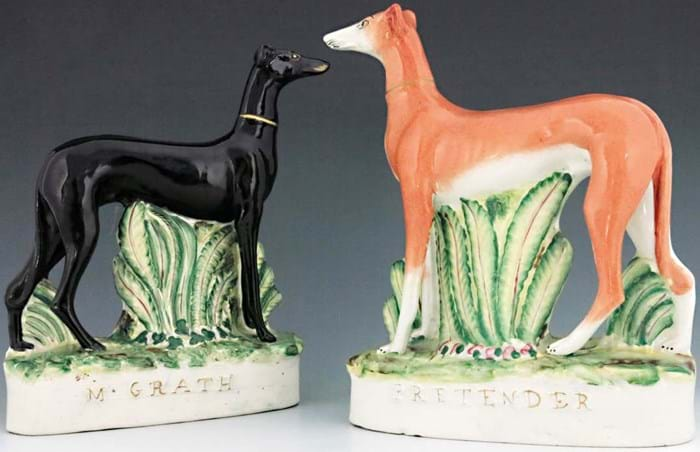
Pair of figures of Master McGrath and Pretender – £3800 at Kinghams' sale of the Harry Ryans collection of Staffordshire figures and animals.
The popularity of pairs of pottery dogs in the Victorian era is often equated with royalty. Queen Victoria’s much-loved king Charles spaniel Dash and Eos, Prince Albert’s favourite greyhound, provided the Staffordshire potters with ample role models.
However, many other Staffordshire figures speak of technological change and the arrival of the mass media. Advances in press moulding and slip casting meant pottery figures could be made quickly and cheaply, while decent likenesses became possible from the 1840s when good-quality illustrations were made available in the form of sheet music, playbills, penny prints and the Illustrated London News. Topicality was everything.
Crimean War theme
Ryans’ group of Crimean War subjects was exceptional. In addition to desirable models of Florence ‘lady of the lamp’ Nightingale and Field- Marshal Lord Raglan (£900 each), other Victorian military figures are less well-known today.
After Raglan had died during the Siege of Sevastopol in June 1855 he was succeeded for just a few months by General James Simpson (1792-1868). His competence as commander-in-chief was quickly criticised by his contemporaries – it was Karl Marx and Friedrich Engels who first used the phrase ‘lions led by donkeys’ in an article published in October 1855 – and he had left the post by November.
A rare large-scale figure of Simpson standing 18in (45cm) high took £850.
Commanding the force until the final evacuation of the Crimea in July 1856 was General Sir William John Codrington (1804-84) who had previously enjoyed success at the battles of Alma and Inkerman. His figure brought £1300.
Made to mark a heroic death – shot through the heart while charging up a hill at Inkerman – a figure of the Duke of Wellington’s former aide-de-camp Major-General Sir George Cathcart (1794-1854) on horseback took £1200, while £1500 was bid for the standing figure of General Sir George de Lacy Evans (1787-1870). Remarkably he served in four wars in which British troops took part during the 19th century, from the War of 1812 to the Crimean conflict.
A good level of interest from established collectors (mirroring that of the Silk collection at Hansons in November) meant Ryans’ collection totalled £127,000 in what is often termed a ‘difficult’ selling environment.
It was proof once again that, unlike some of the subject matter, the market for the best Staffordshire chimney ornaments has not been wholly consigned to history.




